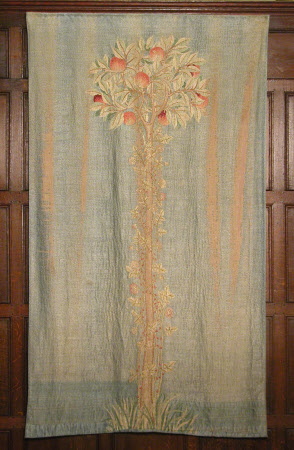Orange tree embroidery
attributed to May Morris (1862-1938)
Category
Textiles
Date
c. 1880 - 1890
Materials
Coloured silks on linen
Order this imageCollection
Bateman's, East Sussex
NT 761662
Caption
William Morris (1834–96), founder of the Arts and Crafts Movement, was one of the most influential designers of the 19th century, and his decorative schemes, based on natural subjects, have become classics of design culture. This embroidered hanging in coloured silks on linen depicts a simple orange tree, grown as a standard, with bushy foliage, golden oranges and roses climbing up its slender trunk. Although previously thought to have been created for William Morris’s home, Red House in Bexleyheath, Kent, it is more likely to be a later adaptation of Morris’s design by his daughter Mary, known as May (1862–1938). The gentle aesthetic of this simple hanging reflects those of the Arts and Crafts Movement, which valued handmade products with a utility of purpose and championed a return to craft traditions. The hanging was used over a door at Bateman’s, the East Sussex home of the author Rudyard Kipling (1865–1936), who was close to the Morris circle.
Summary
An embroidered portière (door hanging) of an Orange Tree designed by May Morris (1862- 1938), c. 1880-90. Featuring a stylised tree, its elongated truck is encircled by roses and surmounted by dense green foliage filled with oranges against a blue ground and is worked in loosely twisted slub silk thread, in shades of blue, green, brown, pink and cream on beige linen.
Full description
The design of this embroidered panel of an Orange Tree at Bateman’s is intrinsically linked to the Arts and Crafts architecture, interiors and furnishings of Red House, the home of William and Jane Morris from 1860 until 1866. William Morris designed a series of embroidered hangings for the dining room depicting twelve female heroines alternated with panels featuring fruit trees. The design relates to two surviving fruit trees from the set; a partially embroidered Pomegranate Tree (V&A: T.124-1985) and a Lemon Tree (Kelmscott Manor). The Orange Tree is taller than the other two, the trunk extended by about 35cm. This suggests that although closely based on Morris’ design, the Bateman’s embroidery may have been made at a later date for a different purpose. The ambitious Red House scheme was never fully realised, and the surviving pieces dispersed after the Morris family left the house. May Morris (1862–1938) was an accomplished designer and embroiderer who became the manager of the Morris and Co. embroidery department in 1885 following her graduation from the National Art Training School. She had been taught by her mother Jane Morris (1839- 1914) a skilled embroider who initially managed the production of embroidered furnishing textiles when Morris, Marshall, Faulkner and Co. was established in 1861. May produced designs in the brand style for use in embroidery kits for portières (door hangings), cushions, fire screens or wall hangings, as well as overseeing commissions for completed pieces. The Orange Tree is first recorded in the collections of writer Rudyard Kipling (1865-1936) at Bateman’s in 1931 where it was used as a portière, its delicate colours softening the wooden panelling. The embroidery is believed to have been worked by Kipling’s mother Alice (1837-1910) who was a keen embroiderer. Along with her sister Georgiana Burne-Jones (1840 -1920, she was an intimate of William Morris’s circle before she moved to India with her husband in 1865, not returning permanently to England until 1893.
Makers and roles
attributed to May Morris (1862-1938), designer Morris & Co., manufacturer
Exhibition history
Lockwood Kipling: Arts and Crafts in the Punjab and London, Victoria and Albert Museum, South Kensington, 2017 - 2018
References
Wilde 2018: Tessa Wilde, William Morris and his Palace of Art: Architecture, Interiors and Design at Red House (London: Bloomsbury; 2018) Parry 1983: Linda Parry, William Morris Textiles, London 1983 White 2017: Catherine White, ‘Wallpapers and Embroidery’ in Marsh, Jan, et al. May Morris: Arts & Crafts Designer (London: V&A/Thames & Hudson, 2017) John Lockwood Kipling: Arts & Crafts in the Punjab and London (Ed.Julius Bryant and Susan Weber) published in conjunction with the exhibition, the Victoria & Albert Museum, 14 Jan - 2 Apr 2017; Bard Graduate Center, New York: 15 Sept 2017 - 7 Jan 2018.
